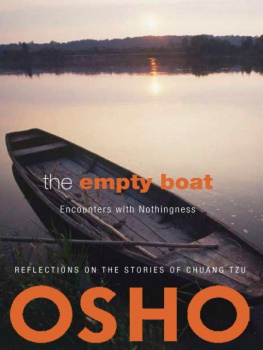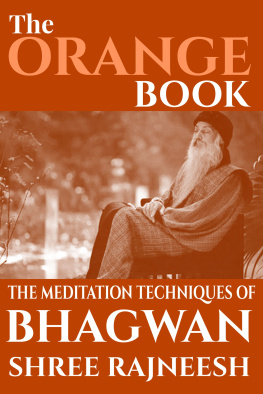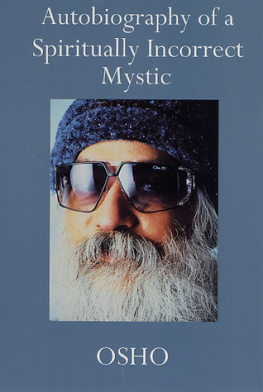THE
RAJNEESH
CHRONICLES
THE
RAJNEESH
CHRONICLES
The True Story of
the Cult That Unleashed the First Act
of Bioterrorism on U.S. Soil
Edited by
WIN McCORMACK

Tin House Books
Portland, Oregon & New York, New York
Copyright 1987
First edition published by New Oregon Publishers, 1987
Second edition published by Tin House Books, 2010
All rights reserved. No part of this book may be used or reproduced in any manner whatsoever without written permission from the publisher except in the case of brief quotations embodied in critical articles or reviews. For information, contact Tin House Books, 2617 NW Thurman St., Portland, OR 97210.
Published by Tin House Books, Portland, Oregon, and New York, New York
Library of Congress Cataloging-in-Publication Data
The Rajneesh chronicles / edited by Win McCormack. -- 2nd ed.
p. cm.
ISBN 978-1-935639-09-1 (ebook edition)
1. Osho, 1931-1990. 2. Rajneesh Foundation International--Controversial literature. 3. Rajneeshpuram (Or.)--History. I. McCormack, Win.
BP605.R342R36 2010
299.93--dc22
2010017031
PICTURE CREDITS: Roger Ressmeyer / Corbis, pages 54, .
Interior design by Ann-Marie Polozova
www.tinhouse.com
CONTENTS


The hottest places in hell are reserved for those who in times of great moral crisis preserve their neutrality.
DANTE ALIGHIERI
The only thing necessary for the triumph of evil is for good men to do nothing.
attributed to EDMUND BURKE
This edition of The Rajneesh Chronicles is dedicated to former Mayor of Antelope, Oregon, Margaret Hill; former Oregon Attorney General Dave Frohnmayer; former Oregon Secretary of State Norma Paulus; former U.S. Attorney for Oregon Charles Turner; and former Oregon Congressman Jim Weaverpublic officials who, in a time of moral crisis in their state, did something.

Asahara... aggressively sought to bring about whatever he predicted.... What made Asahara an action prophet was the inseparability of prophecy and action, of what he imagined and what he did.
ROBERT JAY LIFTON, in Destroying the World to Save It, on the leader of the Aum Shinrikyo cult, which in 1995 released the deadly nerve gas sarin in five subway trains in Tokyo
I n his 1988 novel, S., in which he credits material included in The Rajneesh Chronicles as one of his sources, John Updike tells the story of a housewife in Massachusetts who abandons her husband and middle-class lifestyle to become a sannyasin at a religious commune in Arizona presided over by a guru from India. As described in a book-study guide on the Internet, [l]ife at the commune turns out to be a charade of spiritual enlightenment, a comic rite of sexual initiation, and a wild mixture of jealousy, fraud, embezzlement, and self-deception.
This description fits life at Rancho Rajneesh and the city of Rajneeshpuram in central Oregon during their occupation by Bhagwan Shree Rajneesh and his cohort from 1981-85 pretty wellthough Updike was, of course, creating fiction, as well as applying his characteristic irony to a social situation that, in real life, was not very amusing at all. In real life, the goings-on at this so-called commune were deadly serious, for it was there that the first act of bioterrorism in U.S. historysalmonella poisoning of citizens and officials of Wasco Countywas plotted and launched. It was there also that the same nurse who cultured the salmonella bacteria used in that attack endeavoredin a project with the secret code name Moses Fiveto culture a live AIDS virus, which she must have hoped to use to fulfill the Bhagwans prophecy that two-thirds of the worlds population would ultimately die of that disease.
In his book To an Unknown God: Religious Freedom on Trial, legal scholar and former Washington Post reporter Garrett Epps (who also credits material in the previous edition of this book as a source) correctly identifies the two stages in the Rajneeshees assault on their perceived enemies in the outside world. The first stage involved the poisoning with salmonella bacteria of restaurant patrons in The Dalles, the Wasco County seat, in September 1984, in a test run of one component of their plan to take over the county government in the fall election: disabling opposition voters and preventing them from going to the polls.
When that stage failed, they embarked on the second stage, a plot to kill various people on an enemies list they had compiled. This list included Charles Turner, the then-U.S. attorney for Oregon, who was supervising an investigation of them for immigration fraud and other offenses, and Les Zaitz, an Oregonian reporter then engaged with two colleagues in an extensive journalistic investigation of the cult spanning three continents. It was assumed at the time that the principal objective of Zaitzs investigation was to nail down proof of the Rajneeshees direct involvement, abroad as well as in the United States, in more serious criminal activities, such as drug and currency smuggling and possibly even more sinister crimes.
In his chapter detailing the criminal evolution of the Rajneesh cult, entitled East of Eden, Eppss central focus is on then-Oregon Attorney General Dave Frohnmayer, one of two main subjects of Eppss book, which deals with various conflicts between church and state. Frohnmayer had also made the Rajneeshees enemies list, as a result of the lawsuit he filed calling for the dismemberment of Rajneespuram on the grounds that the intermeshing of Rajneeshs religious foundation and the operations of the city violated the Establishment Clause of the U.S. Constitution. Frohnmayer began his official attorney generals opinion on the matter with a sweeping discussion of religious freedom and the demands of a liberal, secular, democratic order in America. In America, Frohnmayer wrote, [t] olerance is not merely a moral virtue; it is a matter of constitutional policy.
The story of the Rajneeshees in Oregon does raise serious questions about liberal democratic tolerance, and its advisable limits, far beyond the purely religious one. The seeming inability of various governmental entities to deal effectively with the numerous infractions and misbehaviors of the groupits skirting of Oregons land-use regulations and the land-use permits it was granted; its flouting of immigration law through obviously bogus marriages between foreign and American sannyasins; its systematic and cruel persecution of the residents of the nearby town of Antelope, of which it had taken control as a fallback if the city of Rajneeshpuram were declared illegal; its arming of commune residents with semiautomatic weapons while its leaders were issuing threats of violence against the surrounding community and law enforcementsuggested a bewildering and alarming paralysis in the American and Oregon political systems.
Such issues are explored in a 1987 senior thesis entitled Antelope, Oregon and the Need to Revise Liberal Democracies, by Rolf Christen Moan, a student in Harvard Colleges social studies department whom I had the pleasure to advise on his project. My own analysis, which I freely offered him (as a former student in the government department there), was that the American political system is so fragmented, first between the national and local levels, and then, at each level, between different branches of government and entirely separate departments, that no one entity or political leader or official had the overall authority to confront the fundamental challenge the Rajneeshees presented. Moan, however, mainly concerned himself with the proposition that the tolerance of a liberal democratic system might extend too far, allowing organizations subversive of the public order to operate with dangerous impunity within its borders.














![Rajneesh Gupta [Rajneesh Gupta] - Hands-On Cybersecurity with Blockchain](/uploads/posts/book/119697/thumbs/rajneesh-gupta-rajneesh-gupta-hands-on.jpg)

 Tin House Books
Tin House Books
